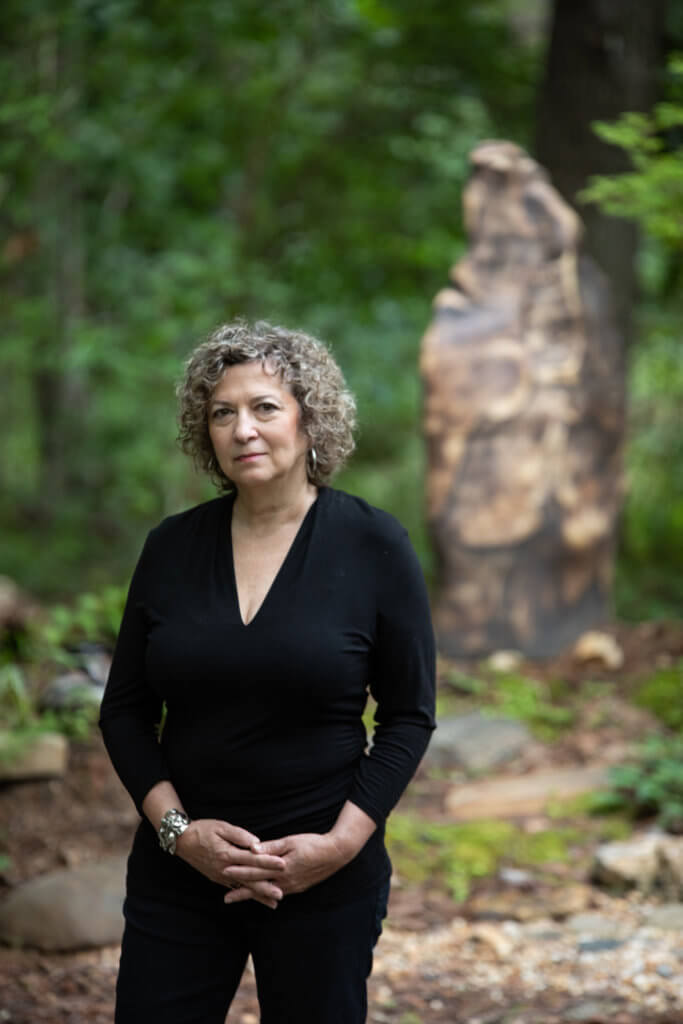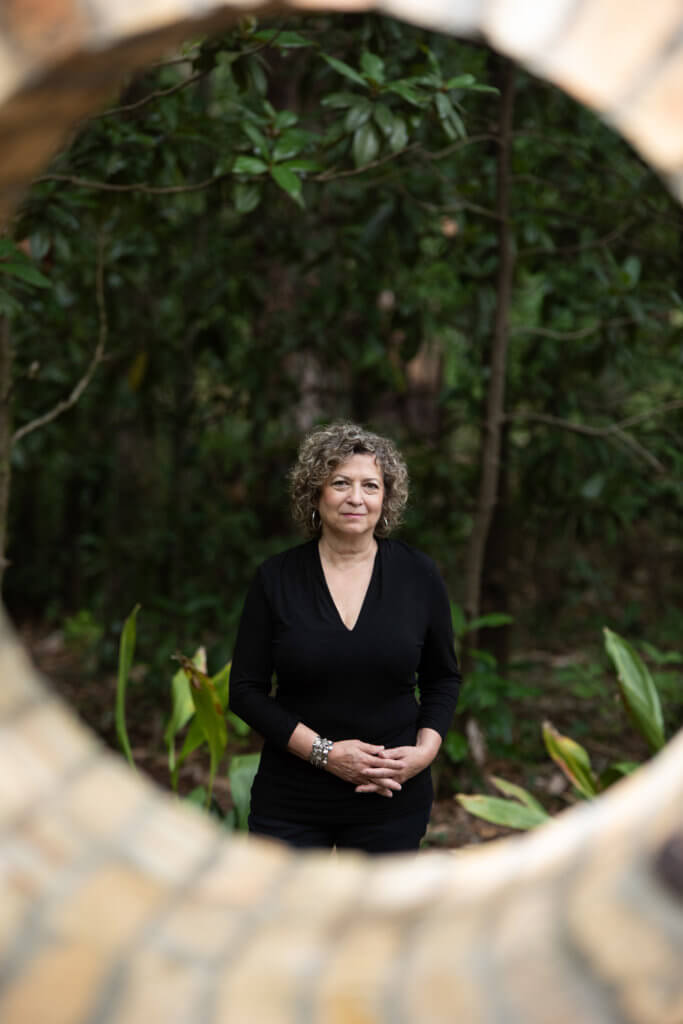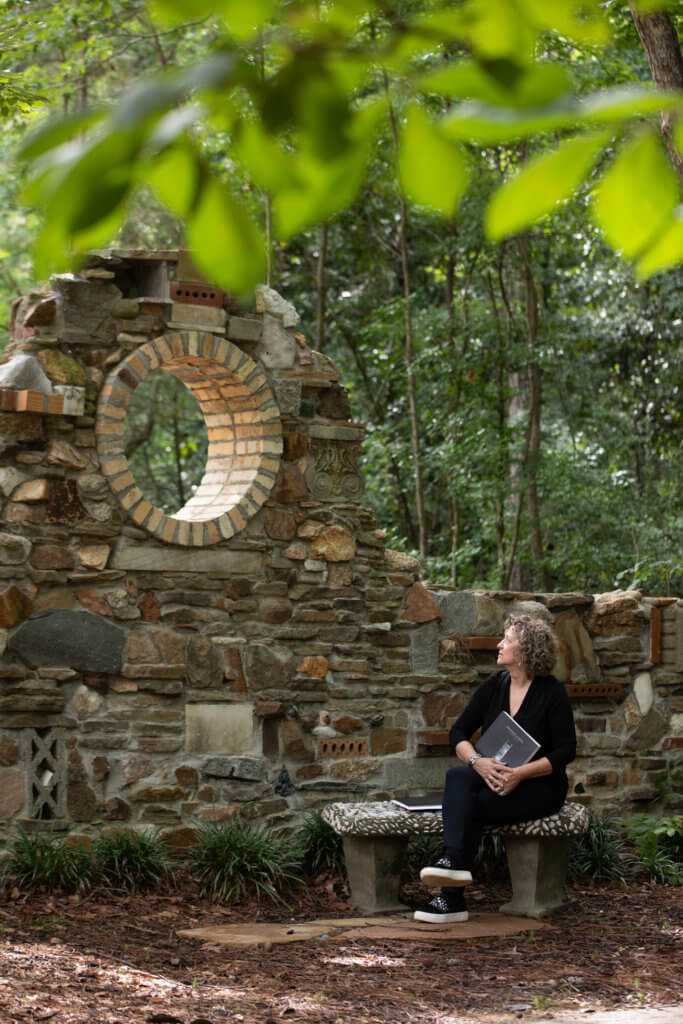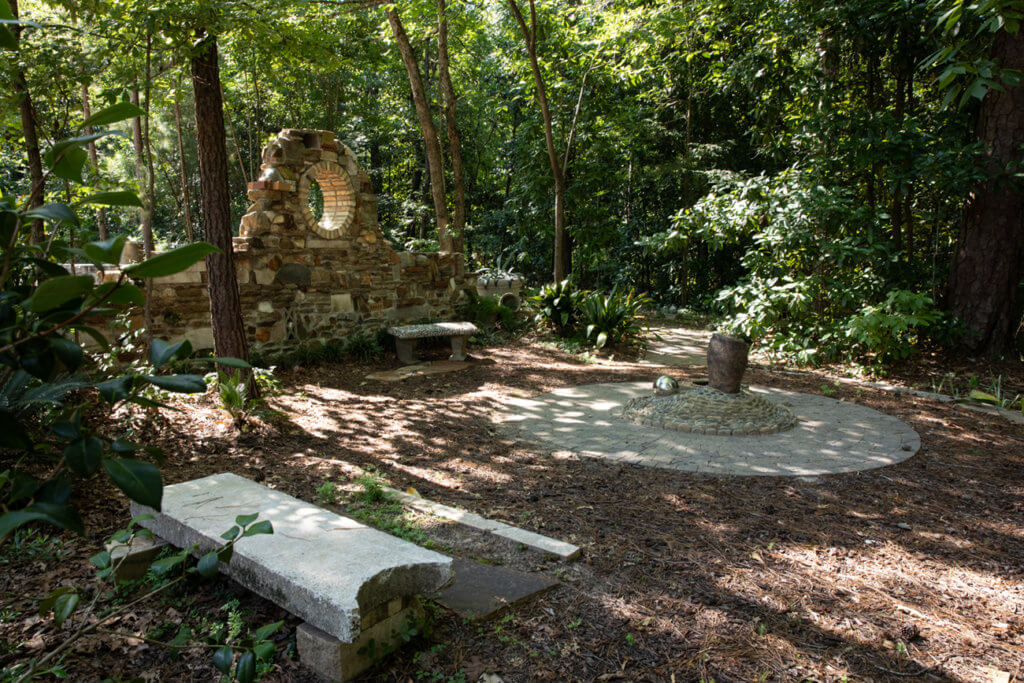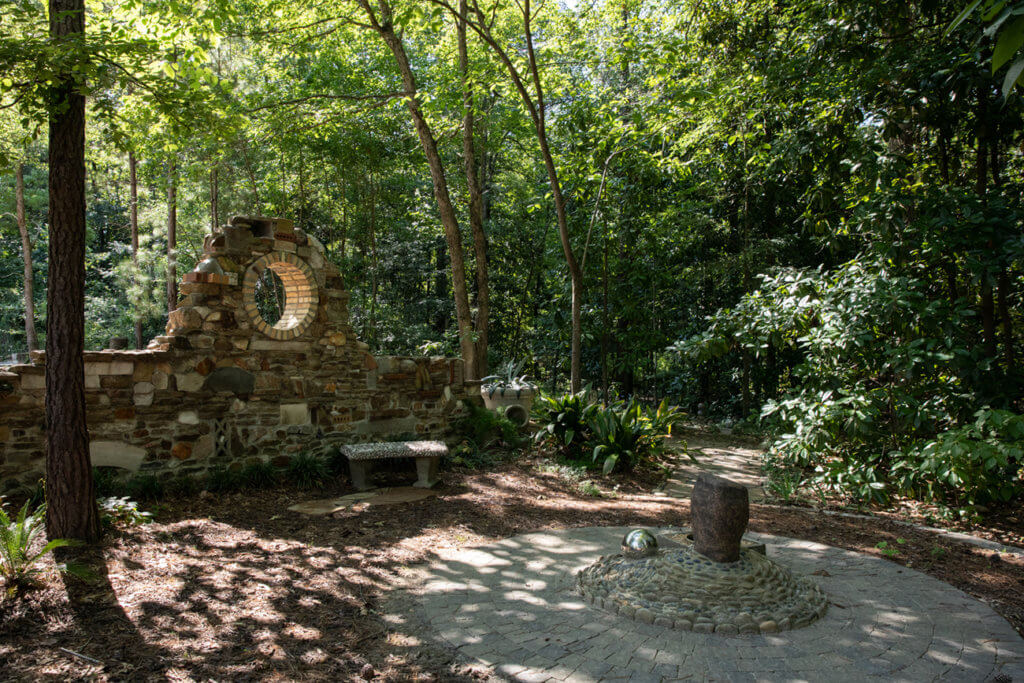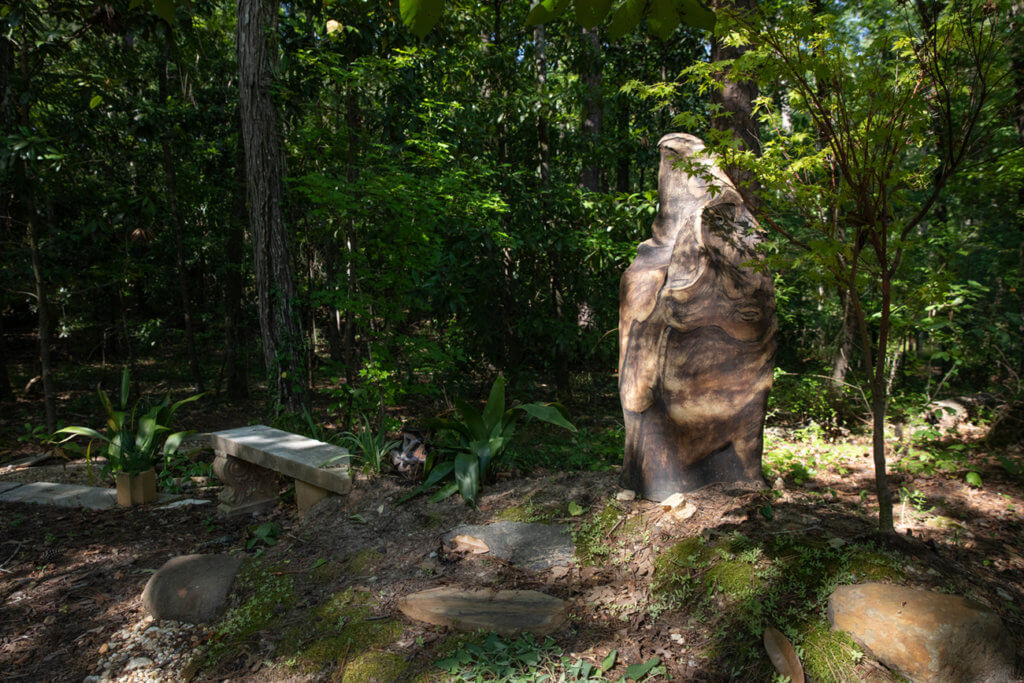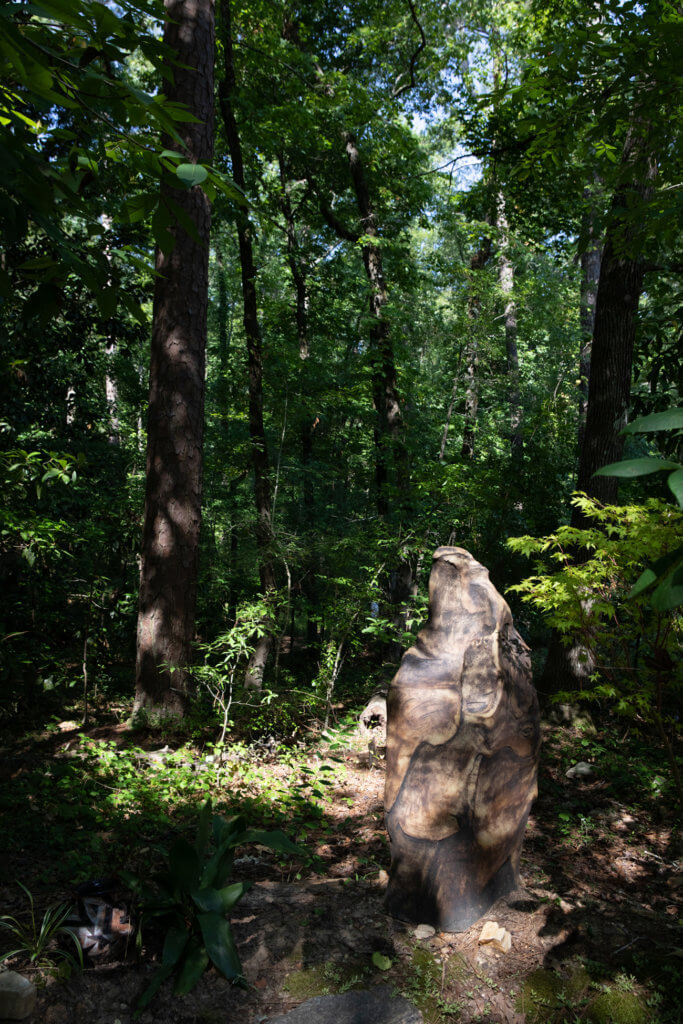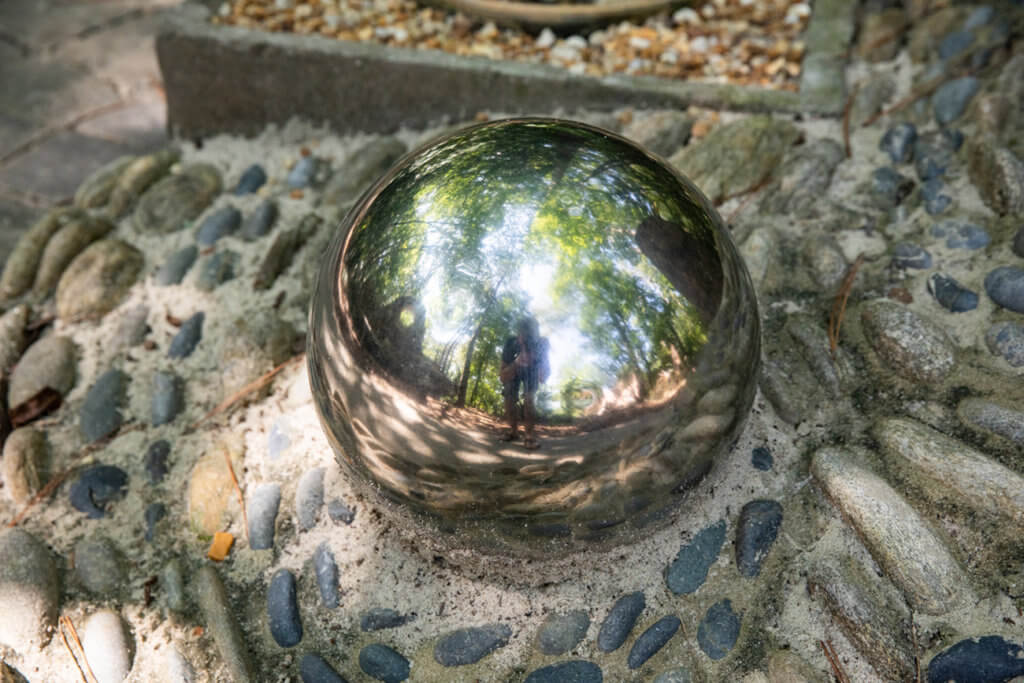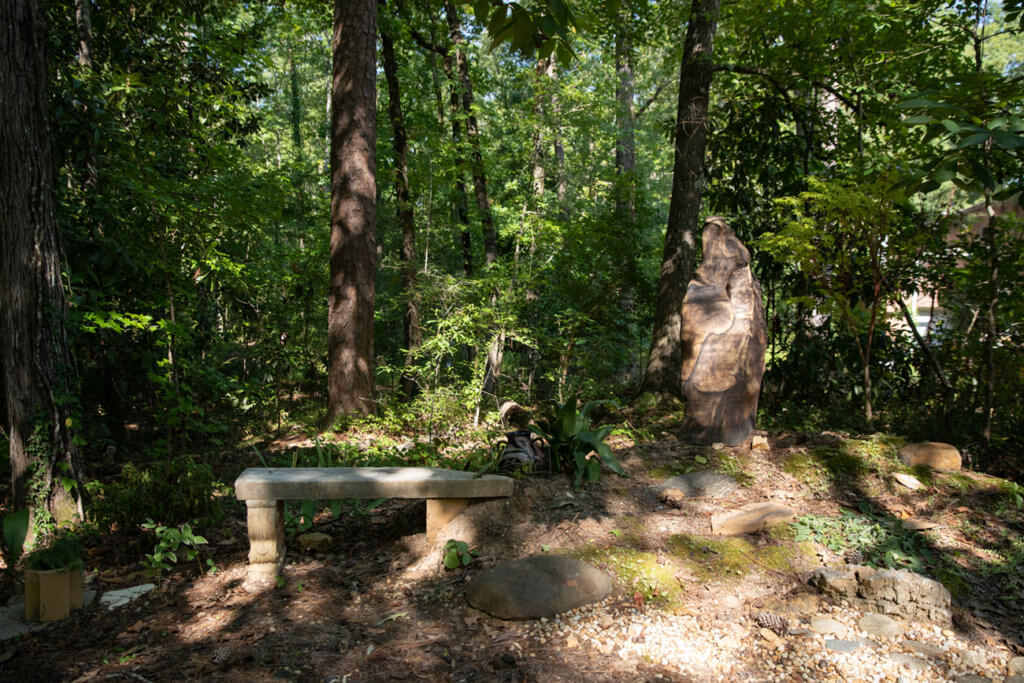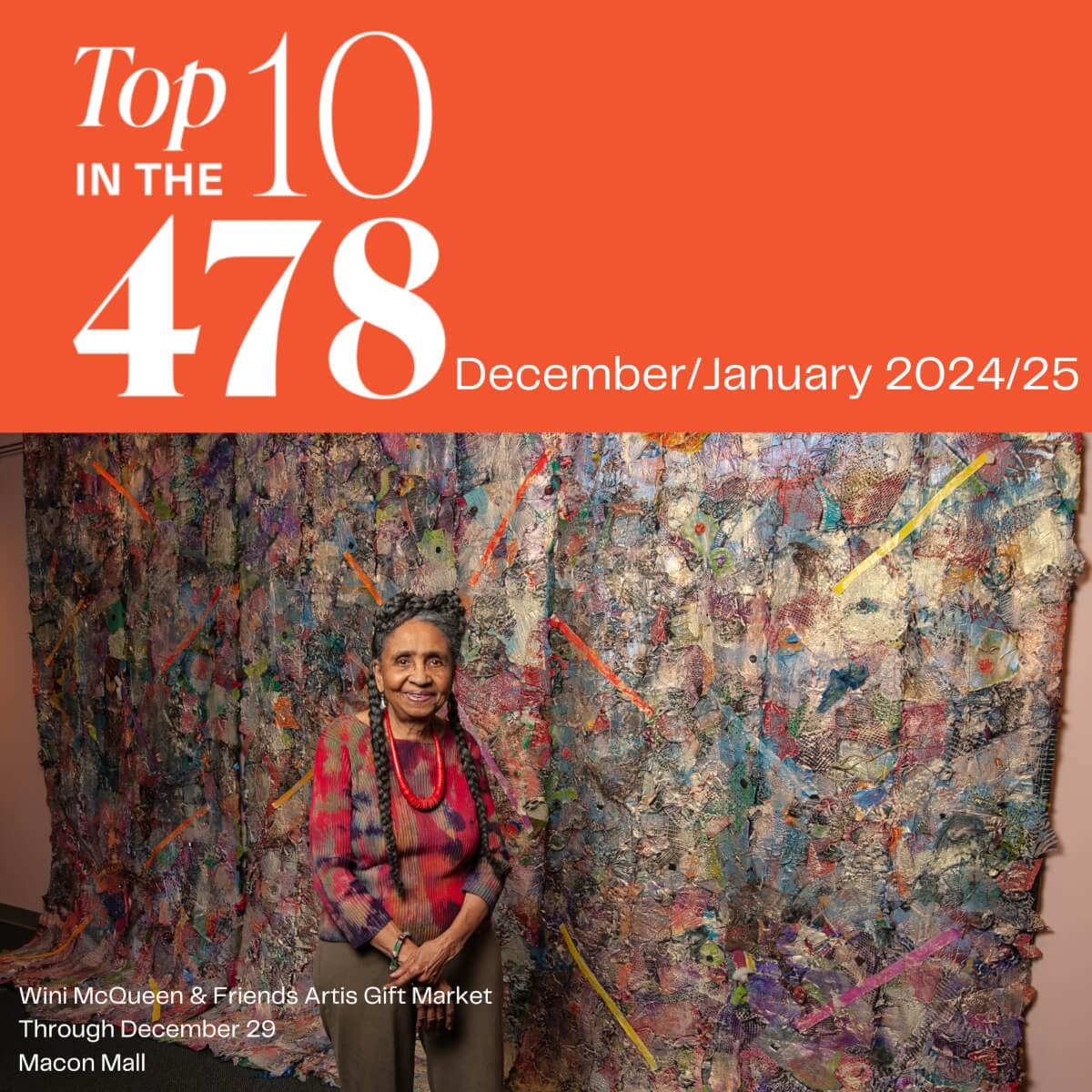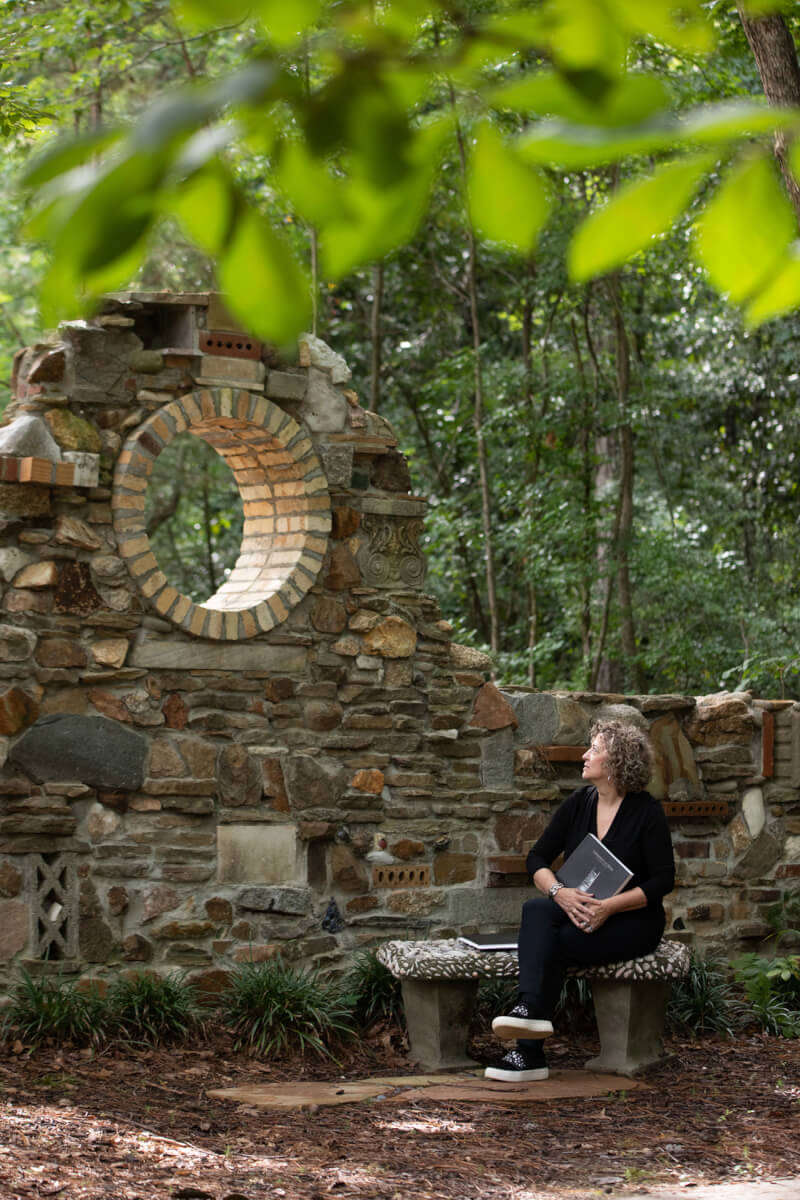
Natural Reflection: Fernando La Rosa Memorial Garden a tribute to inspiration
By Jami Gaudet
Photography by Christopher Smith
How do you mend after the death of the man with whom you shared your life for 32 years? How do you create a lasting memorial for your husband, Fernando La Rosa, beloved art professor and photographer of international stature that’s as expansive as his outsized personality?
Frances de La Rosa, painter, sculptor and venerated art professor in her own right, is nothing if not determined and industrious.
“I knew Fernando wanted to be cremated. And since religion wasn’t a thing with us, there never was a conversation about a service,” Frances de La Rosa explained.
After Fernando’s passing on Nov. 5, 2017, Frances envisioned an exhibition of his work. But she also aspired to create something more enduring to remember him — not just as an artist or a person, but as a teacher who “demanded excellence and investigation and challenged his students to reach deep into themselves to create something evocative.”
Wesleyan College, Fernando’s academic home for 19 years, joined Frances in hosting a month-long exhibition in January 2018 entitled, “Seizing Life: Through the Lens of a Photographer.” A sizable circle of the couple’s friends and colleagues gathered at the opening to mourn Fernando’s passing and hail his fine art photography.
The carefully chosen compendium of photographs curated by Frances was presented in two galleries in Porter Auditorium — one a retrospective spanning more than 40 years, the other, photographs on loan from the private collections of local friends and collectors.
At the opening, Frances gave an art talk describing Fernando’s work as “a quest to find contrast between the rectilinear and the organic,” describing him professionally as a skillful photographer who created powerful images and drama in black and white. In his work as in his life, she said, “Fernando displayed a dark, dense, shadowy kind of strength.”
A month later, Fernando, who founded the first photography gallery and school in Peru, was commemorated at an exhibition in Lima, and in August was feted at the International Photography Festival for his contributions to Latin American photography.
In the five years leading to his death, the dynamic professor faced a string of physical challenges — a superbug known as MRSA, knee replacement surgery, heart trouble for which he received a pacemaker, and finally, a diagnosis of appendix cancer.
“Despite declining health, Fernando remained positive and health-minded, but the cancer diagnosis was a total shock. I knew no treatment would resolve it, and death wasn’t too far in the future. Yet he continued to be lively and physically active — teaching his classes until two weeks before he died,” Frances said.
As Fernando weakened and traveling became difficult, Frances suggested that they think about their home as a destination, the place they’d dream of traveling to, and began formulating plans to create a lasting tribute to the man who meant so much to so many.
Although not a gardener himself, Fernando appreciated his wife’s love of horticulture and observed her handiwork from the screened porch outside his home studio, where he relaxed and smoked his pipe. Frances smiled at the memory: “He enjoyed that peaceful place where he could sit and look and be thoughtful.”
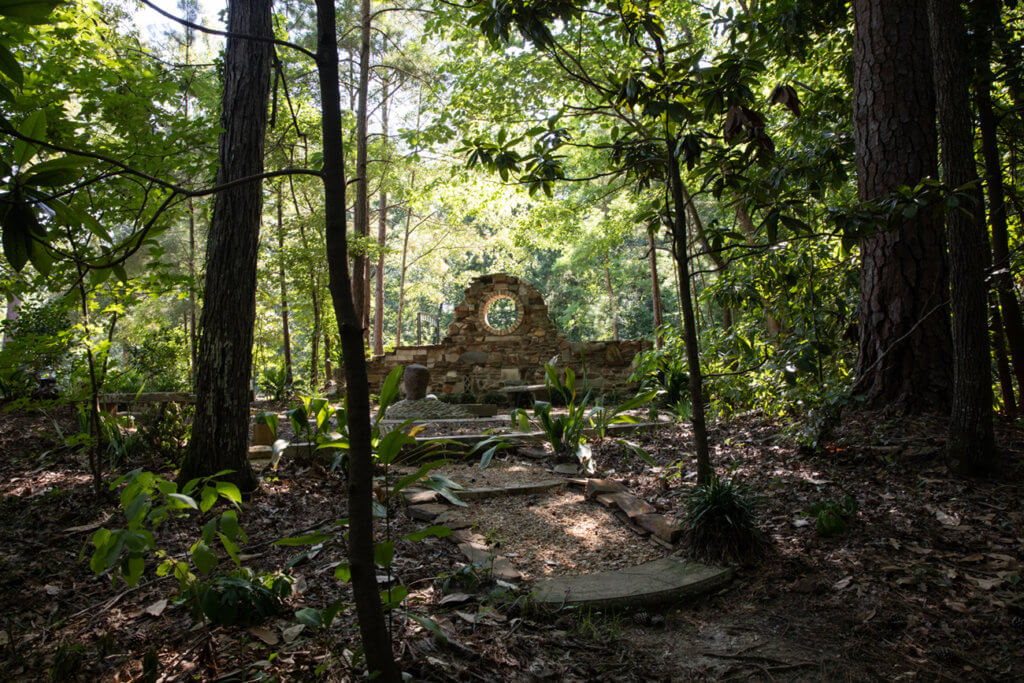
Fernando was an apple aficionado, sharing one daily with Frances. But knowing their yard was too shady for an apple tree, Frances decided to plant a memorial apple tree on Wesleyan’s campus, and the idea of a garden began to grow.
With early support from Wesleyan College President Vivia Fowler and Development Director Andrea Williford, Frances began picturing a location for Fernando’s apple tree and garden — adjacent to the art building and arboretum where an art pad already functioned as an outdoor classroom.
Frances recalled years earlier that Fernando was captivated by local artisan Tanner Coleman’s transformation of a concrete slab at the edge of the Wesleyan campus into an “art pad” — 1960s hippie speak for a home or hangout.
“Years earlier, by accident, I uncovered the footer of a building and discarded pieces of granite and marble,” Coleman said about his discovery. “I’m a place maker. I saw a special place in the making and wanted to capture the space. Fernando was a friend and real spirit, and all of us who worked on the garden with Frances clung to that.”
Frances presented garden designs and drawings to Fowler and Williford so they would have a visualization of the project, “something I insist on in my own students,” she said. “As a painter, I work in solitude, but enjoyed thinking the garden through, even though it was outside my field of experience.”
So, Frances marshaled a team of artisans and volunteers to construct a garden “that was its own thing while enhancing the art pad and complimenting, not competing with, the arboretum.”
Even as she grappled with the multitude of decisions inherent in a project of this scope, the garden gave her purpose and a productive counterpoint to her anguish.
“Saturating myself in the creative process and working with talented individuals was therapeutic,” Frances said.
From the outset, people donated money to the garden, but, given the expense of materials and labor, Frances committed to minimizing the costs for both. A native Alabaman, she likened that challenge to the Southern practice of “making do”— using what’s at hand, despite limitations.
So, Frances and Coleman continued his practice of sourcing materials from a remote area of campus where broken ceramics, granite, cast concrete planters, broken stone and other remnants were stored, and the pair began rescuing and repurposing them.
THE GARDEN
The entry, a brick and metal archway designed by Coleman and sculptor Jim Bodell, is anchored by brick columns carved by students in ceramic classes taught by Coleman and his wife, Wesleyan art professor Alexis Gregg. The couple own AnT Sculptural Design, a boutique firm in Macon specializing in public art and architectural ceramics carved from wet clay bricks.
Gregg, who serves on Wesleyan’s arboretum committee, was interested in continuing to develop the art pad, located steps from one of several entrances to the arboretum, as an outdoor art gallery.
Student art work appears throughout the garden, including handcrafted tiles at the entrance and three tall ceramic totems, two of fanciful creatures and the center one inspired by Fernando’s work. One whimsical motif, Frances’ favorite, features two cameras, his signature pipe and Mr. Potato Head, a fixture on his desk at work.
Flanking the totems is Fernando’s apple tree, the species known as Anna, bred in Israel and chosen for its ability to thrive in hot climates. Although self-pollinating, a small white crabapple tree was planted close by to increase the size and yield of the fruit.
The garden’s centerpiece is an imposing stone wall 23-feet long and 10-feet high, inspired by the Wall of Gifts at Highgrove, the country home of Prince Charles and the Duchess of Cornwall.
Frances, the garden’s unofficial project manager, credited Coleman with engineering the wall, a painstaking process that took several months. The wall’s unexpected design element, an oculus, is a reference to the aperture of a camera and Fernando’s penchant for photographing landscapes through windows.
Local craftsman John Wilson, who created the bottom portion of the wall, and Coleman, responsible for the top portion including the oculus, fashioned the structure with two truckloads of stone given to Wilson by a friend.
In turn, Wilson gifted the collection to the garden and incorporated Fernando’s personal gifts and relics as embellishments — a chunk of the Berlin Wall, vestiges of Frances and Fernando’s homes, architectural elements found on campus and pieces of students’ ceramic art.
Initially, Wilson and his two assistants were hired as paid masons, but with funds rapidly depleting, Wilson donated his time and talent to ensure the wall’s completion.
“Typically, I work in construction, so I jumped at the opportunity to do something so creative and lasting,” he said. “I love the feel of stone, and choosing where to place teach piece. I was happy to collaborate with Frances on Tanner and Alexis’ design.”
The oculus entices visitors to gaze through it to discover another section of the garden, the focal point of which is two concentric circles of rocks. A shell-topped bench donated by ceramics artist Amy McCullough joins other primitive benches for conversation or contemplation.
The outer circle stone was contributed by a family friend, Stephen Reichert, who hired his nephew, John Reichert, to lay it.
“I see his work every day in my home and enjoyed being involved in a project for such a good cause,” said John Reichert, who owns several of Fernando’s photographs, including landscapes, seascapes and a waterfall.
A small, raised inner circle of upright river stones contains three embedded elements: a stainless-steel gazing ball, a bowl encased in a pebbly surround and a ceramic replica of a pre-Columbian Peruvian head sculpted by Frances and based on one of Fernando’s favorite photographs.
Frances’ own talent was key to the memorial garden in innumerable ways — her imagination, designs, sketches, landscape choices and sculpture, including the large clay Asian/Zen style Scholar Stone beyond the stone circles. Replete with significance, it’s a nod to Fernando’s love of teaching, enthusiasm for photographing stone and is evocative of his childhood frolicking among Peru’s Incan ruins.
In another corner, a Machu Pichu inspired planter fashioned and donated by Fernando’s student Kristen Beasley holds flowers and greenery. The garden’s florals are simple and white in keeping with the peacefulness and spirituality of a place of memory and characteristic of the white blooms found in Japanese gardens.
Frances describes the Fernando La Rosa Memorial Garden as an enclosed, private, natural space that creates circumstances for introspection. She’s gratified to see people strolling through the sanctuary observing each element devotedly crafted by her small band of artisans. People read, socialize and meditate in the garden, and before the COVID-19 pandemic struck, it was a popular site for wedding, engagement and prom photos.
Gregg called the garden a sacred space.
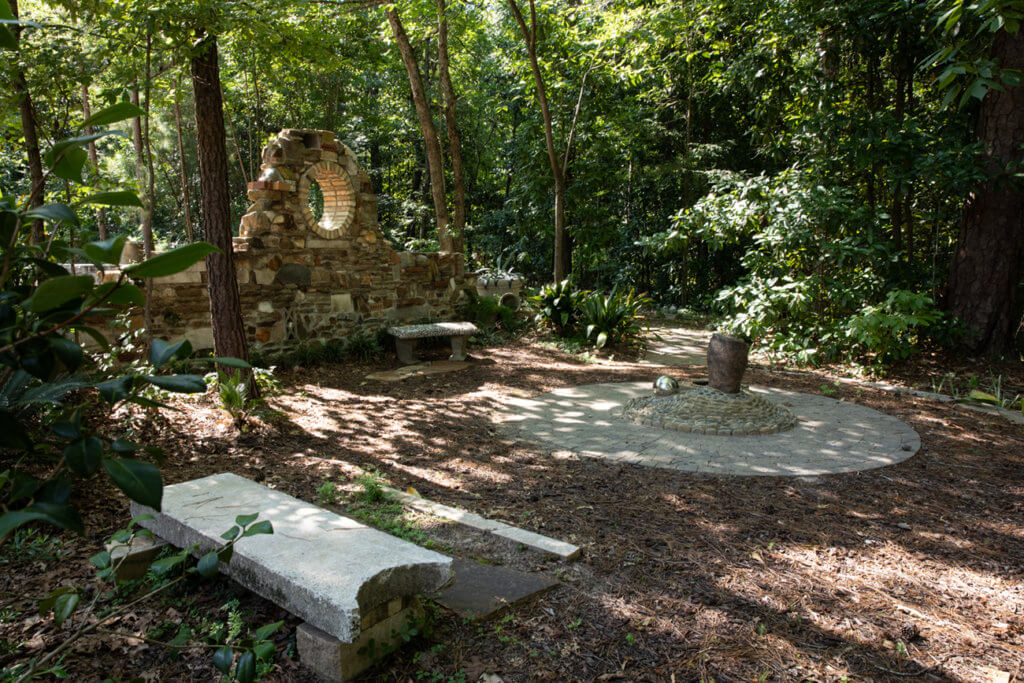
“I love the personal touches, and while it’s very personal to me, it can impact anyone,” she said. “It makes me feel at home and gives me a sense of ownership and belonging in the community we’re a part of.”
Frances enjoys visiting the garden and thinks about Fernando when she’s there, but doesn’t have to be there to think about him. When asked how Fernando would like it, she replied, “I think he would find it quite a treasure — a place to sit, smoke his pipe and be thoughtful.”
Fernando La Rosa in the classroom
Fernando La Rosa was a towering figure in the art world and in the classroom he so deftly commanded.
With exhibitions across the U.S., Europe, Central and South America, he was credited as the founder of artistic photography in contemporary Peru.
He embodied the teacher he longed for as a young man but which eluded him, imparting what one student said were “valuable lessons on the true meaning of life and art.” In academia, he’s remembered with reverence and affection as a “beautiful spirit.” One student said, “he had a zest for life, excitement and creativity in all its forms.” Another called him “my greatest teacher, no doubt.”
Students loved his swagger, referring to him as “talented, funny and so damn cool.” But he was a tough taskmaster, always challenging his pupils. One admitted, “I was intimidated by his energy.” Another said, “he approached his craft and teaching with truth — sometimes poetically, sometimes brutally, always with impact.”
Of his photography they said, “it moved me to tears” and “it stilled my soul.” Another added, “Dr. La Rosa communicated wisely and truthfully in his craft and his teaching.” Students were grateful for his devotion to his own art and to theirs, remarking, “he encouraged my passion in photography in a way no one had before.”
To see more
Contributions to the garden can be directed to the Fernando La Rosa Memorial Garden at Wesleyan College. Learn more at https://www.facebook.com/groups/414009075823073
See more of Fernando’s photography by visiting http://fernandolarosa.com/index.html, and more of Frances’ work at https://francesdelarosa.com/home.html.




